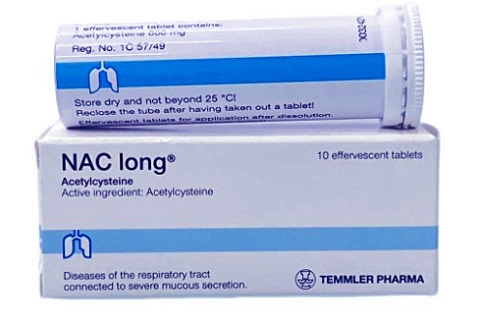Nikhil Prasad Fact checked by:Thailand Medical News Team Oct 29, 2024 5 months, 2 weeks, 19 hours, 16 minutes ago
Medical News: A team of Italian scientists from the University of Rome "Tor Vergata" and the University of Parma have recently explored the potential benefits of N-acetylcysteine (NAC) in managing mucus overproduction, a core issue for patients with chronic obstructive pulmonary disease (COPD). This
Medical News report investigates their systematic review, which highlights the ability of NAC to reduce mucus hypersecretion, bringing new hope for improved respiratory health in COPD patients.
 Promising Role of N-Acetylcysteine in Reducing Airway Mucus in COPD Patients
Why Mucus Overproduction Matters in COPD
Promising Role of N-Acetylcysteine in Reducing Airway Mucus in COPD Patients
Why Mucus Overproduction Matters in COPD
Excessive mucus is more than an inconvenience for COPD patients; it poses significant health risks. COPD, a progressive lung disease, restricts airflow and makes breathing difficult. One of the main symptoms is chronic mucus hypersecretion (CMH), where the body produces more mucus than it can effectively clear. In CMH, the airways become obstructed by mucus plugs, leading to difficulty breathing and frequent exacerbations or flare-ups. This study sheds light on how NAC might help control mucus secretion and improve quality of life for COPD sufferers.
The study's findings, which evaluated over 20 studies on NAC's effects, found that NAC, a known mucolytic, could go beyond thinning mucus. The researchers report that NAC may also inhibit mucus production at the source, specifically targeting the MUC5AC and MUC5B mucin proteins that contribute to excessive mucus in COPD. Their findings suggest NAC’s dual role as both a mucolytic (breaking down mucus) and a mucoregulator (controlling mucus production).
The Study Findings: NAC’s Broad Effects on Mucus Reduction
The research team analyzed a range of studies that examined NAC’s effect on various conditions related to COPD, including viral infections, bacterial infections, cigarette smoke exposure, and oxidative stress. Their findings show NAC’s consistent impact on reducing mucus-related symptoms across different models. Notably, NAC was shown to significantly decrease the gene expression of MUC5AC and MUC5B - key mucus-producing genes - by blocking pathways that stimulate excess mucus production.
-Effects of NAC on Viral and Bacterial Infections
In conditions mimicking viral infections, such as those caused by respiratory syncytial virus (RSV) or influenza, NAC was found to reduce both gene and protein expression of MUC5AC. This means that when cells are infected, they respond by producing less mucus, thanks to NAC’s inhibitory action. Similar results were found in bacterial infection models, where NAC prevented overproduction of mucus proteins typically seen in infections with pathogens like Pseudomonas aeruginosa and Streptococcus pneumoniae.
-NAC's Role Against Inflammatory and Oxidative Stress Factors
In response to environmental pollutants and irritants like cigarette smoke and PM2.5 (particulate matter), which exacerbate mucu
s production in COPD, NAC was observed to significantly reduce the MUC5AC protein expression. This ability to counteract environmental stressors holds promise for smokers and those exposed to high pollution levels. Additionally, NAC’s antioxidant properties may further protect lung tissues, reducing inflammation that otherwise worsens mucus production.
-Experimental Findings on NAC and COPD Models
Studies on animal models with COPD induced by cigarette smoke exposure showed that NAC led to reduced goblet cell hyperplasia, a condition where mucus-secreting cells multiply excessively. NAC treatment also decreased the production of both MUC5AC and MUC5B proteins in these COPD models. These findings suggest that NAC can directly influence mucus-producing cells, reducing the likelihood of mucus blockages and airway obstructions, which are common in COPD.
How NAC Works at the Cellular Level
NAC’s primary action is thought to involve breaking disulfide bonds within mucin proteins, which makes the mucus less sticky and easier to clear from the airways. However, NAC also impacts intracellular signaling pathways responsible for inflammation and oxidative stress, which are often heightened in COPD. The review highlights that NAC may suppress these pathways, reducing the inflammatory signals that usually lead to excessive mucus production. Thus, NAC serves not only as a mucus-thinner but also as a preventive agent against mucus overproduction.
Implications for COPD Patients and the Path Forward
Given the serious health impacts of chronic mucus hypersecretion in COPD, these findings suggest a potential shift in treatment options. NAC, already used as a standard mucolytic in respiratory care, may offer additional therapeutic benefits as a mucoregulator, reducing the root causes of mucus overproduction. This dual role of NAC is significant, as it could help prevent airway blockages, reduce flare-ups, and ultimately improve respiratory health for COPD patients.
The study concludes that while NAC holds promise as a mucoregulator, more clinical studies on human bronchial tissues are essential to confirm these effects. Research into targeted delivery systems, such as inhaled NAC, could also optimize its effectiveness, particularly for patients who need regular respiratory support.
The study findings were published in the peer-reviewed International Journal of Chronic Obstructive Pulmonary Disease.
https://www.tandfonline.com/doi/full/10.2147/COPD.S474512
For the latest Medical Research News, keep on logging to Thailand
Medical News.
Read Also:
https://www.thailandmedical.news/news/new-research-suggests-n-acetylcysteine-nac-may-help-manage-chronic-pain
https://www.thailandmedical.news/news/medical-news-polish-study-finds-n-acetylcysteine-and-sulodexide-exhibits-protective-properties-on-endothelial-cells-exposed-to-sars-cov-2
